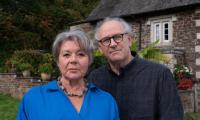Sanity seems to be prevailing in the Syrian conflict. The two most powerful leaders of the world – US President Donald Trump and his Russian counterpart Vladimir Putin – agree that the Syrian conflict cannot be resolved through military means.
After meeting briefly on the sidelines of a regional summit in Vietnam last week, the two leaders said there was “no military solution” to the war in Syria. The statement, issued by officials from both sides, said the two presidents had made progress on Syria, a country that has been battered by six years of civil war.
It is disappointing to see that powerful world leaders only spring into action after a lot of blood has already been spilled. This has also happened in the case of Syria where, according to the Syrian Centre for Policy Research (SCPR), 470,000 people were killed until March last year with up to 1.9 million Syrians injured. This means that more than a tenth of the population has either been killed or wounded. Even the conservative estimate puts the death toll as 250,000. In addition to this, the conflict has displaced than six million people within the country while another four million have been forced to seek shelter as refugees in other countries. Life expectancy in the hapless country also dropped from 70.5 years in 2010 to an estimated 55.4 years in 2015. The war has cost a whopping $226 billion to the Syrian economy.
When the civil war erupted, thousands of militants, many of them from Western countries, started flooding into conflict zones controlled by Isis. Blinded by their hatred for Bashar al-Assad, these countries did not come up with an effective policy to at least prevent the flux of the jihadis pouring into Syrian territories. The international community turned a blind eye towards these militants until the extremely violent extremists started slitting the throats of foreign hostages, burning people alive and raping hapless Yazidi women. No question was raised over the overt and covert support to Al-Qaeda elements by Western powers.
In the name of fighting Isis, the US and its allies were alleged to have targeted the Syrian troops that were trying to eliminate the very elements that the Americans were claiming to fight. Washington was blamed for bombing Syrian government posts, thereby allowing Isis remnants to escape. If the Russians and Americans were opposed to the extremist group, then why was no joint front formed to stamp out the menace? Why did anti-Isis forces not unite for this purpose? Why was action not taken in time – action that could have saved several millions people from the life of death and misery that they are condemned to lead now?
While the statement of these two world leaders over the situation in Syria is encouraging, one wonders why such approach is not applied to other conflicts as well. Why are the two leaders silent over the devastating invasion of Yemen by Saudi Arabia? More than 10,000 people have perished in that war-torn country since the Saudi-led coalition launched an attack in March 2015. According to the UN, nearly 19 million people – 80 percent of Yemen’s population – are in need of humanitarian aid; more than three million have been displaced.
A catastrophic humanitarian crisis is already unfolding in the hapless country where Saudi bombardment has decimated water and sanitation system, triggering an outbreak of various diseases including cholera. According to the World Health Organization’s count of October 1, there were 777,227 suspected cases of cholera in the war-torn country, taking only about six months to reach those alarming high numbers. More than half of the cholera patients are under the age of 18 and 26 percent are under the age of five. It took Haiti seven years to report over 800,000 cholera cases but in Yemen it happened within six months, thanks to the ruthless bombardment that has destroyed the infrastructure of the country.
The international community has adopted a criminal silence over this devastating war. Instead of extinguishing the flames of war, the so-called civilised countries further stoked it by lavishing arms deals on the conservative kingdom. Ignoring the starving faces of the Yemeni masses, US President Donald Trump visited the kingdom with killing machine deals worth over $300 billion. And the UK’s arms sale to the Saudi government have increased 50 times since the launch of the invasion in March 2015.
Washington threw its blanket support behind the Saudi ruling elite that now appears to be planning to trigger another conflict in Lebanon, while Moscow is reluctant to dissuade Iran from reining in Tehran’s proxy in Yemen. Even China, which is pumping over $900 billion into the ambitious ‘One Belt One Road’ project, is trying to keep itself aloof from these raging wars, ignoring the fact that the flames of war sometimes tend to be very unpredictable.
As if these conflicts were not enough, the US is raising the spectre of war and destruction in the Korean Peninsula. The fear-mongering that Trump spread during his recent visit to South East Asia was aimed at selling more American arms to its rich allies like Japan. The Oval Office incumbent did not hide his intentions. During his recent visit to Japan, Trump while pointing at Japan’s PM Shinzo Abe, said: “He will shoot (North Korea’s) missiles out of the sky when he completes the purchase of lots of equipment from the United States. One very important thing is that Prime Minister Abe is going to be purchasing massive amounts of (US-made) military equipment, as he should. We make the best by far….it’s a lot of jobs for us and a lot of safety for Japan.”
This statement by Trump clearly indicates that even if the Syrian crisis is over and the much-awaited-peace has been brought back to the war-torn country, the pernicious tentacles of death and destruction will find another battlefront because the gargantuan appetite of the military-industrial complex is not likely to wither away any time soon. The merchants of death and destruction, who control the world through their businesses, might force the international community to turn a blind eye to the simmering tension between Iran and Saudi Arabia, the spectre of a devastating war in Korean peninsula and a possible conflict in Lebanon. Once the flames of war have engulfed these countries, they will again come up with their arms deals to bless the world with misery, death and destruction.
Trump and Putin must agree that it is not only the Syrian conflict that needs no military solution but that no armed solution is workable anywhere. Both countries are the biggest manufacturers of arms and possess the most lethal agents of destruction. They should not only get rid of those arms but should also muster up support for peaceful resolutions of conflicts. They need to play their due role along with China, the European Union, Brics and other regional bodies and international bodies in seeking a peaceful solution of armed conflicts across the world. One way to achieve this is to make a commitment to seek the gradual dismantling of the military-industrial complex, not only that of US only but of all the states of the world.
The writer is a freelance journalist.
Email: egalitarianism444@gmail.com
People stand in line up as election officials check their ballot papers during voting general election at a polling...
Women show their voter identity cards as they stand in a queue before casting their votes in Agartala. — PTIThe 18th...
Former prime minister Imran Khan. — Instagram/ imrankhan.ptiAn old saying has it that “when you dance with the...
Kashmiris in Indian illegally occupied Kashmir protesting against the Indian occupation as the forces of India looked...
A representational image showing residents walking at a wholesale market in Karachi. — AFP/FileOnce again there is...
A representational image showing late Pakistani human rights activist and Supreme Court lawyer Asma Jahangir. —...







